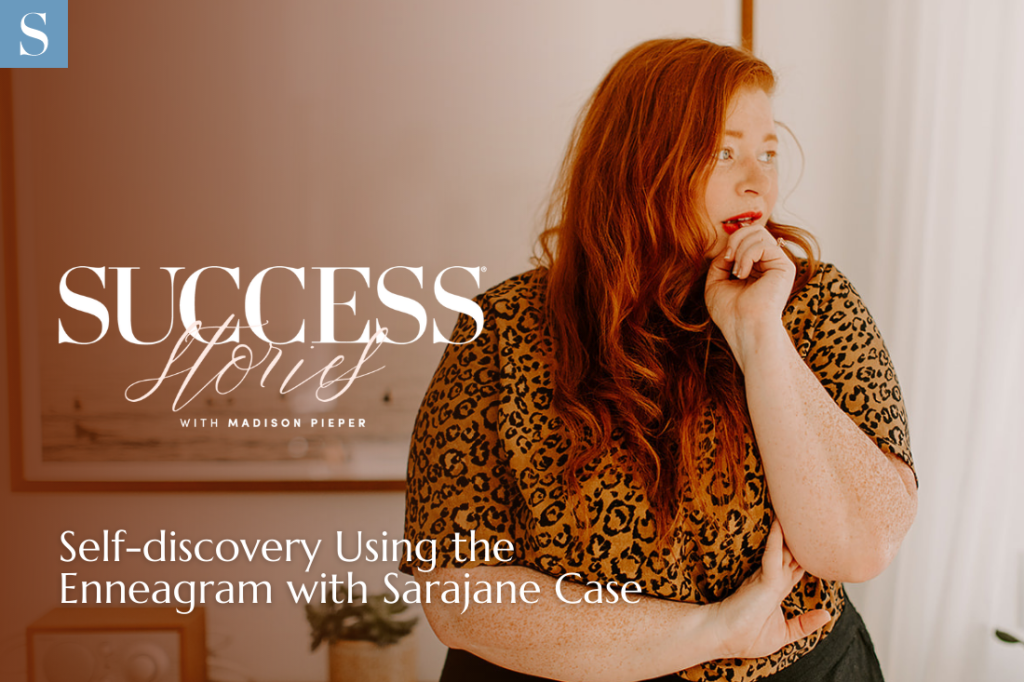When you’re trying to untangle the complicated mystery of your own personality, it helps to have a guide.
Sarajane Case has always been fascinated by why people behave the way that we do, and how we can make better choices. When she discovered the Enneagram, it felt like the key to getting as close to those answers as possible.
“We’ve boiled it down into the essence of why people do the things they do,” she says of the test.
Sarajane is bringing that key to everyone else, through her book The Honest Enneagram: Know Your Type, Own Your Challenges, Embrace Your Growth, and her podcast Enneagram & Coffee.
In this episode of SUCCESS Stories, Sarajane talks to SUCCESS’s Madison Pieper about how to find your Enneagram type, why it’s more than just a number, and how it can help you better understand the forces and experiences that drive you.
What Is the Enneagram?
The Enneagram is a personality test that divides everyone into one of nine categories, numbered one through nine, based on our fundamental motivations, fears and worldviews.
Briefly, the nine types are:
- Type One: The Reformer, who wants to make the world a better place.
- Type Two: The Helper, who believes they earn love through good deeds.
- Type Three: The Achiever, who believes they earn worth and value through their actions.
- Type Four: The Individualist, who believes their uniqueness is what makes them important.
- Type Five: The Investigator, who fears being incompetent and incapable, and focuses on getting informed.
- Type Six: The Loyal Skeptic, who seeks external support and safety.
- Type Seven: The Enthusiast, who prioritizes keeping their options open, and fears being trapped emotionally.
- Type Eight: The Challenger, who believes they have to fight their way to the top.
- Type Nine: The Peacemaker, who focuses on their own peace of mind, and fears alienation from others.
None of the numbers are worse or better than the others. Every Enneagram type has its own strengths and weaknesses. The point is to understand which one you are so you can make the most of the positive traits that come with it, and mitigate the impact of the negative aspects.
How to Discover Your Enneagram Type
Sarajane says that one place to start is with the many online quizzes that promise to tell you your type.
If you do three different quizzes and get the same number every time, that’s a good indicator that you fit into that category. From there, you can read up on your number using a more detailed resource, like her book.
It’s OK if you get different answers each time, too. Sarajane recommends taking the three types that are coming up most frequently, and doing further research to find out which one fits you best. That doesn’t mean choosing the one you most want to be, however.
If reading a description of one type makes you feel like someone put you in the center of a bright spotlight, you’re probably on the right track. “See if any of those make you feel uncomfortable, maybe a little bit exposed,” Sarajane says. “When I read mine, it felt like reading my journal out loud.”
Soul Children and Wing Numbers
You have one main Enneagram type that doesn’t really change as you get older. But you can also complement that with certain other Enneagram numbers. For example:
Wing numbers: The types on either side of your Enneagram type are called your wing numbers. Some people find that one or both of these types influence their main Enneagram type.
For example, a Three (Achiever) with a wing Two (Helper) channels their energy into work that supports others. “Like an entertainer or a host,” Sarajane says. In contrast, a Three with a wing Four (Individualist) is more likely to find value in projects that center themselves.
Wing numbers don’t work the same way for everyone. Some people lean more to one versus the other, some draw on both, and some don’t use either.
Soul child: Each Enneagram type has a respective soul child number: the Enneagram type that reflects how you feel when you’re at your most restful, and the way you were as a child. For example, for Enneagram Type Six (the Loyal Skeptic), the soul child is Type Nine (the Peacemaker).
Knowing your soul child can help you understand why you have the fears, goals and worldview that you do. “Your Enneagram type formed as an armor to protect that tiny version of yourself,” Sarajane explains.
For example, she says, people who are Type Six now—an anxious type—used to be “calm and cozy” Type Nines. “Somewhere along the way, they learned that wasn’t OK, that they needed to be on guard, they needed to be skeptical, they needed to figure out who they could and couldn’t trust,” Sarajane says.
How to use the Enneagram as a tool for growth.
The Enneagram isn’t just about slapping a number on your personality. It’s about using the information about your type to play into your strengths and account for your weaknesses.
Sarajane recommends meditation as a useful tool that can help you get better at recognizing when you’re leaning into the worst traits of your type, and to make a different choice.
That involves being honest with yourself about areas you struggle with, as well as areas where you excel. “There’s nothing wrong with not being good all the time, or not being perfect all the time,” Sarajane says. “We need to look at it as information, and do what we can with it: support our strengths and really let them shine, and then find ways to ease and soften our way to growth.”
Knowing you fit into one Enneagream type doesn’t mean you can only behave in ways that comply with that type. Your instincts may always lead you back there, but the more you grow and the more you understand about those instincts, the more you can exercise control over your choices.
“We have all nine types available to us, so we get to choose how we show up in any given situation,” Sarajane says. “We don’t have to show up as our type.”
SUCCESS Stories with Madison Pieper is no longer releasing new episodes on the SUCCESS Podcast Network, but you can still listen to the full conversation below.




